School Cafeteria Pizza
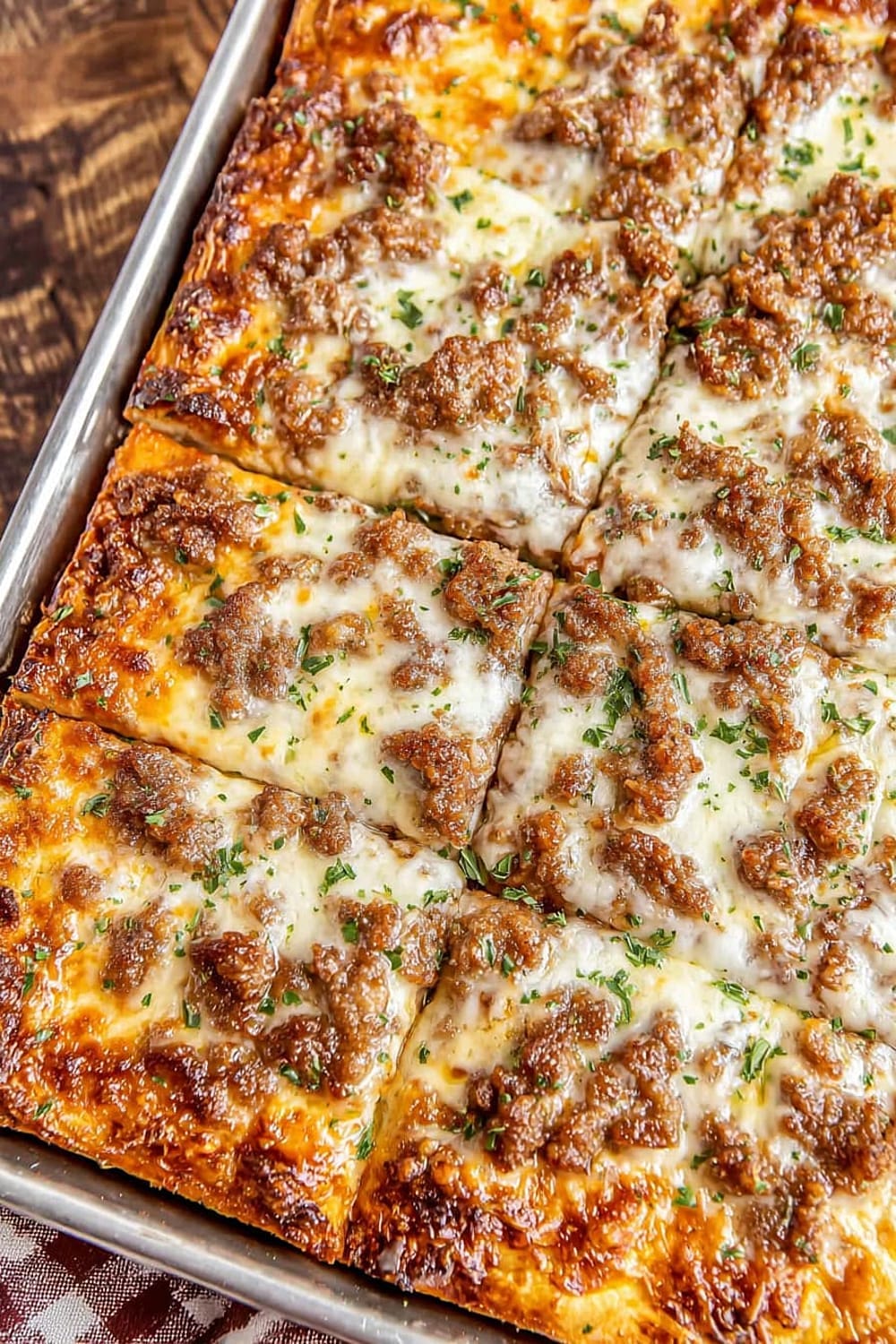
This recipe is basically a time machine disguised as pizza dough that’ll transport you straight back to the lunch line where you’d pray for pizza day.
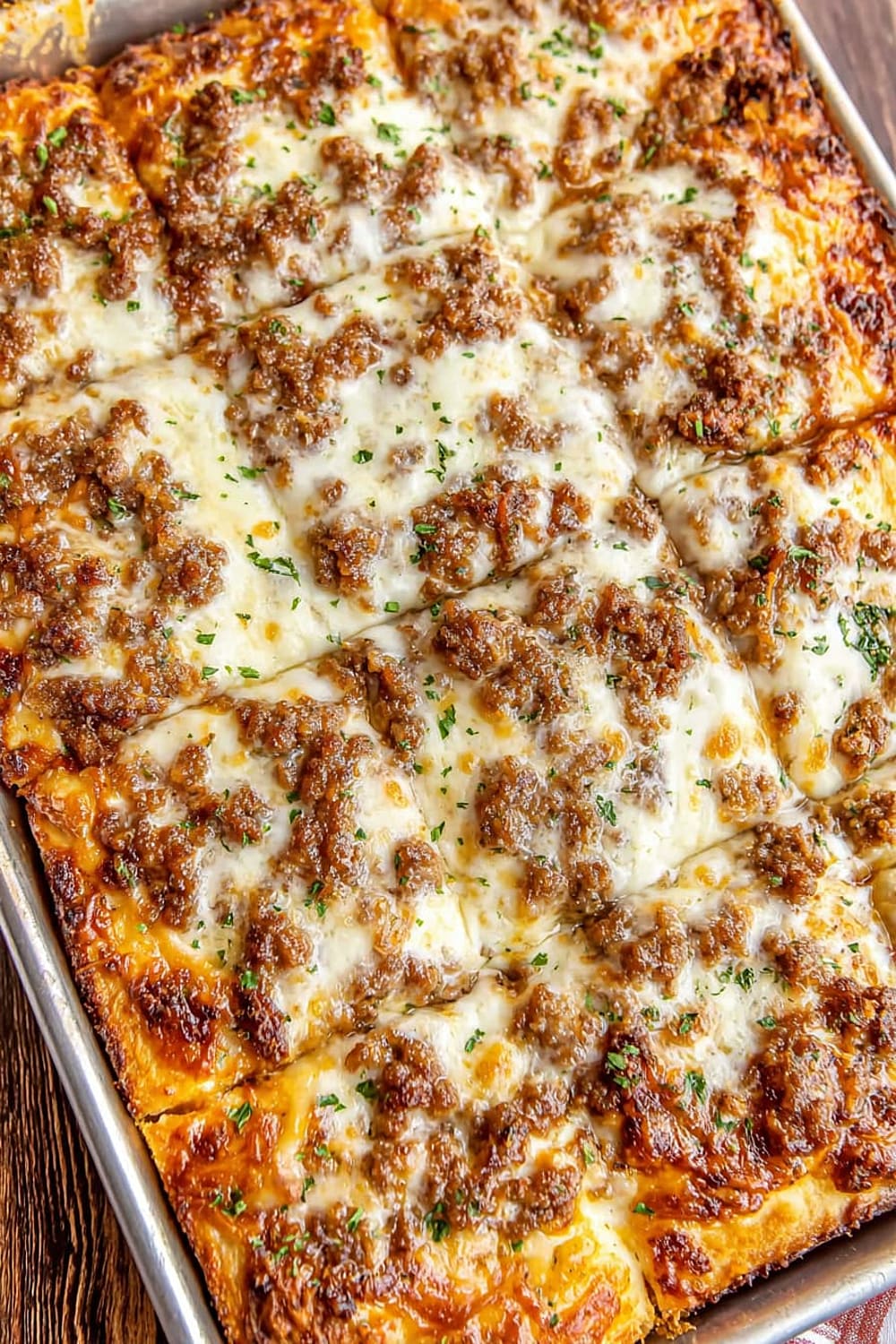
Forget everything you think you know about pizza making because this government-issued recipe breaks all the rules with its genius pourable batter that somehow creates the exact rectangular perfection you remember.
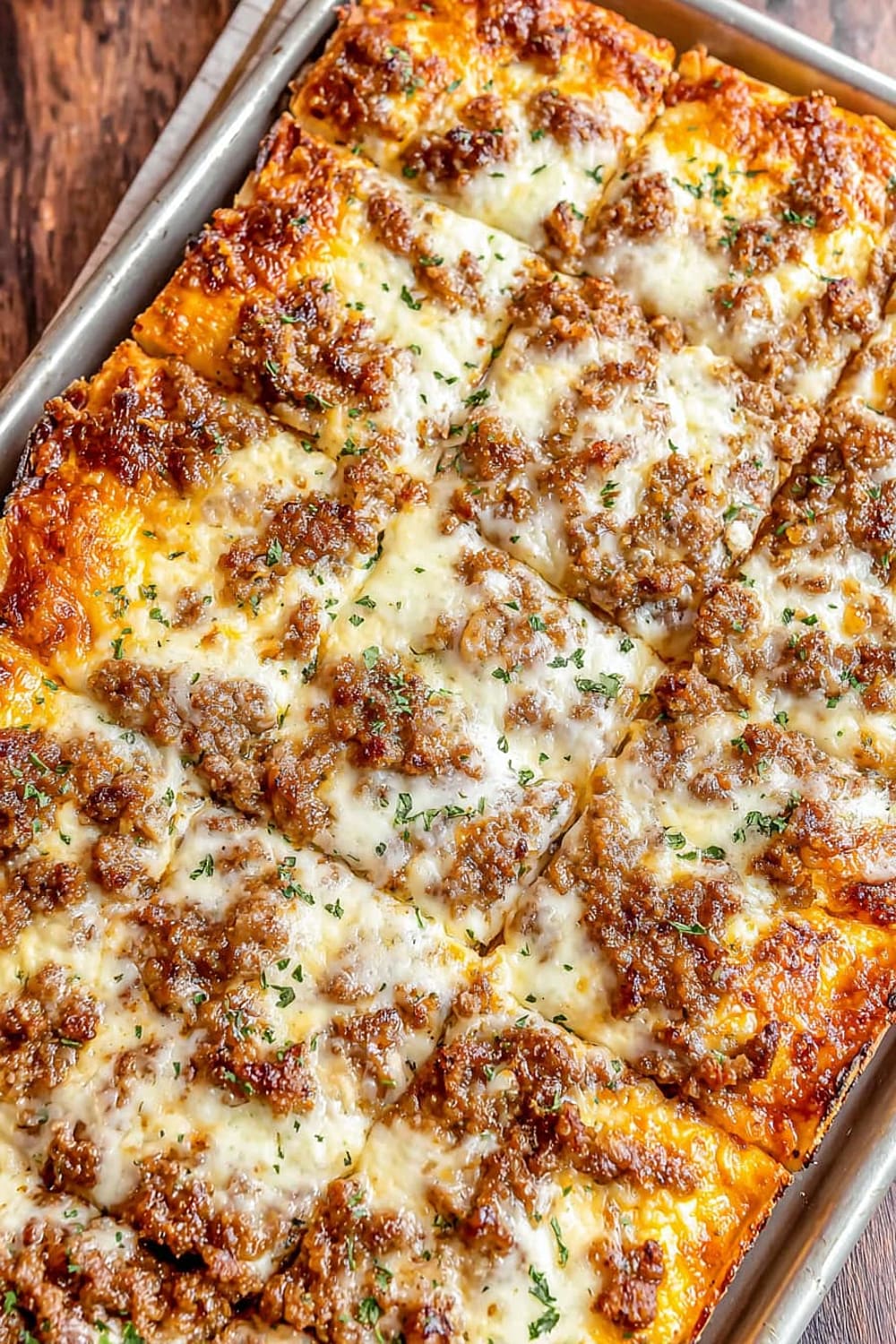
The secret weapon here is that ridiculously simple batter made with instant dry milk powder and just enough oil to create that slightly crispy yet tender crust that made cafeteria pizza legendary.
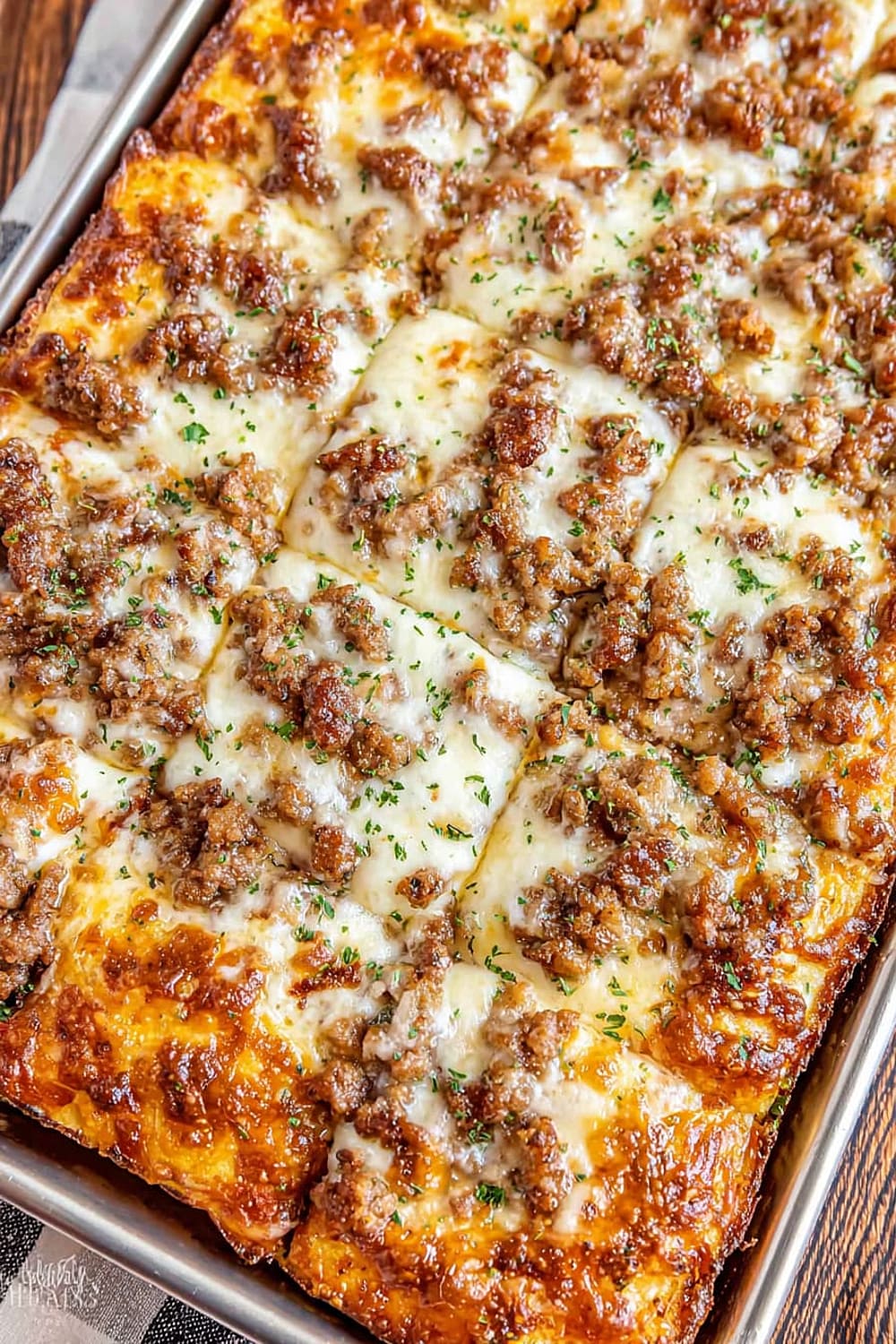
Warning: making this will result in people asking “Wait, this tastes exactly like school pizza!” while simultaneously reaching for their third slice because nostalgia is delicious.
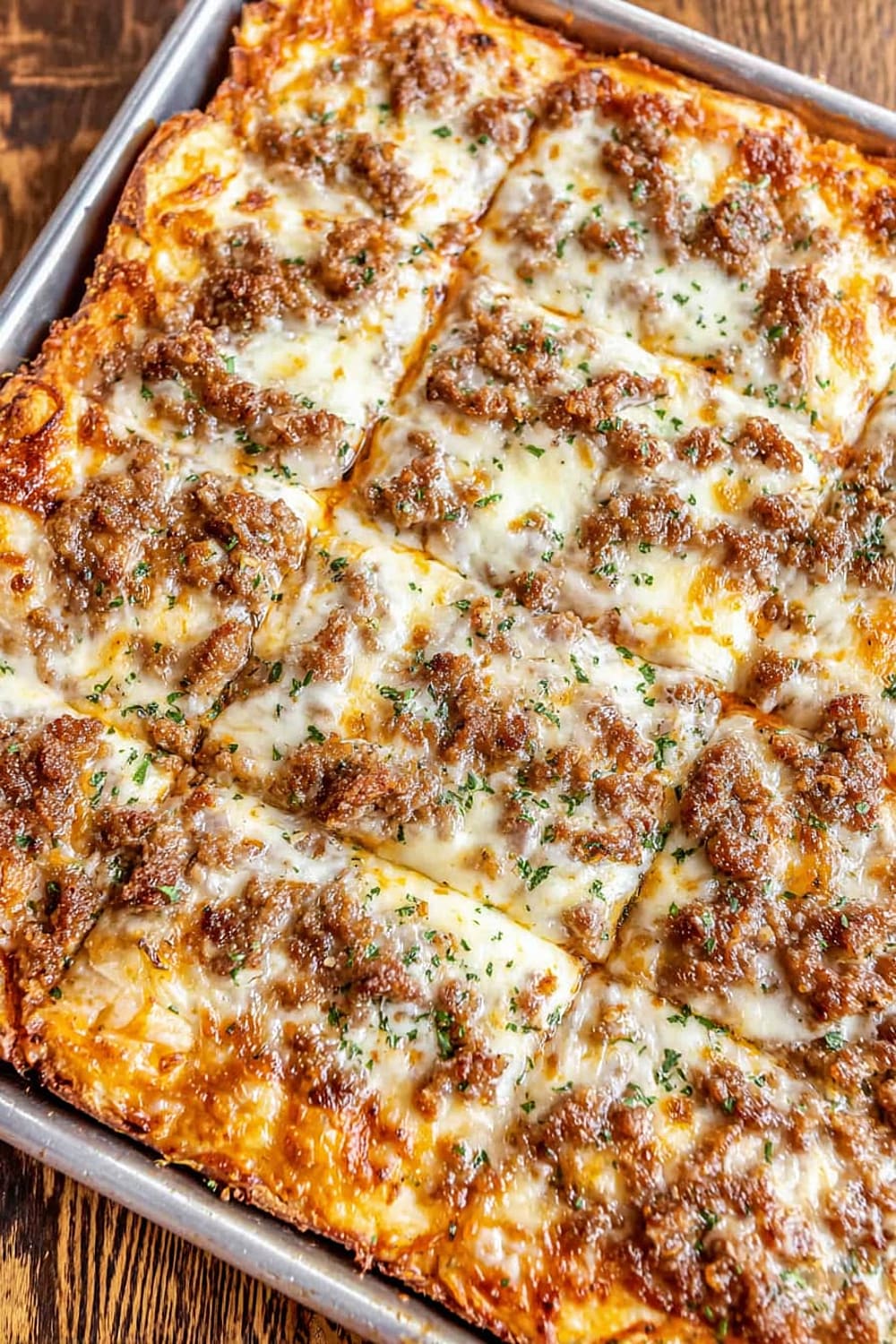
This is the kind of recipe that proves sometimes the most unassuming government cookbook holds the keys to pure comfort food magic that fancy pizzerias spend years trying to replicate.
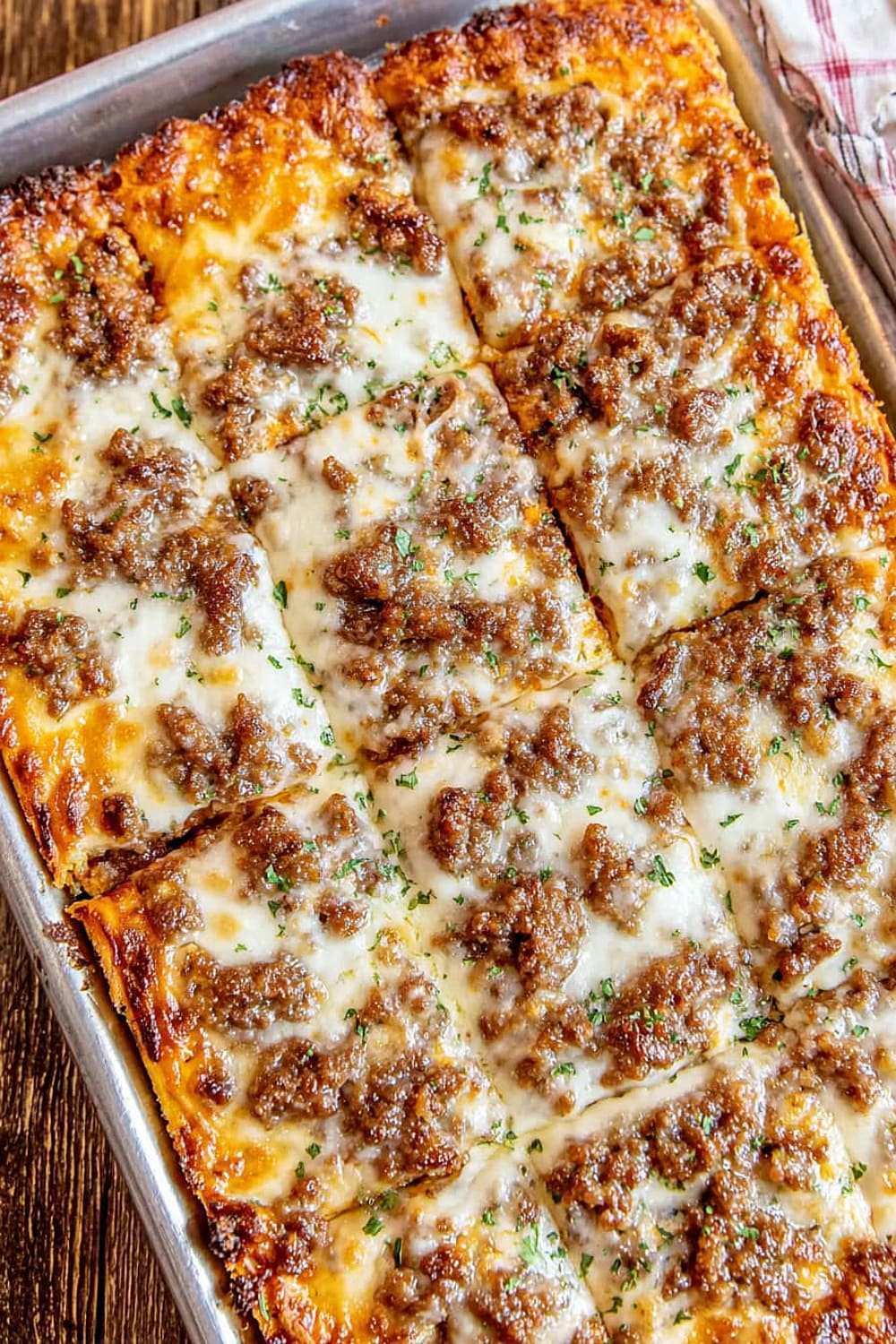
Get ready to become the hero of every potluck and family gathering because you’ve cracked the code on the most requested pizza style that somehow disappeared from most people’s lives after graduation.
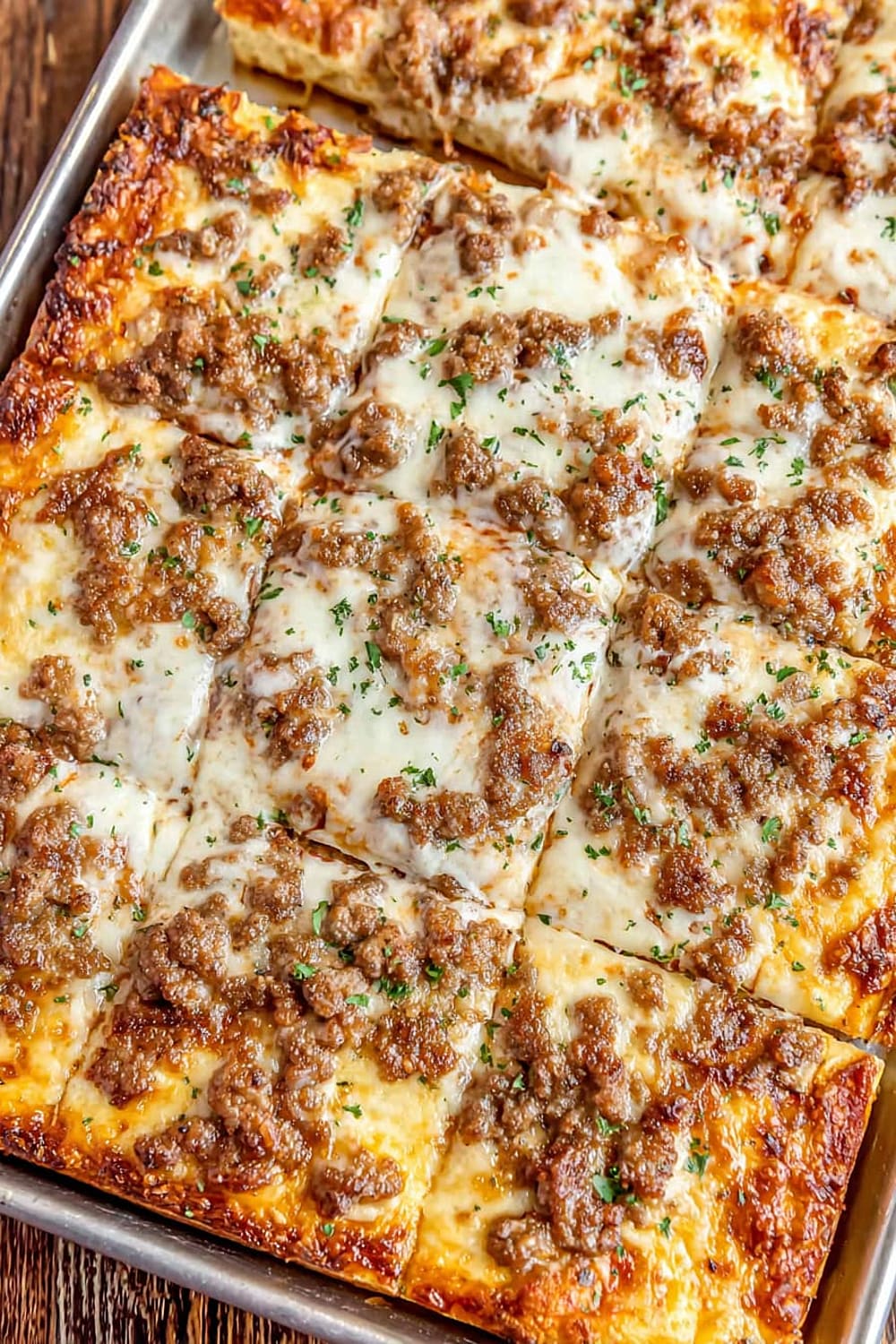
Ingredients
For the Pizza Crust
- 1 tablespoon Crisco shortening (for greasing)
- 1½ tablespoons cornmeal (for dusting)
- 1 (0.25-oz) packet active dry yeast
- 1⅔ cups warm water
- 2½ cups all-purpose flour
- ¾ cup instant non-fat dry milk powder
- 2 tablespoons granulated sugar
- ¼ teaspoon salt
- 1½ teaspoons vegetable oil
For the Pizza Toppings
- 1⅓ cups pizza sauce (or to taste)
- 2 cups shredded mozzarella cheese (or to taste)
- Pizza toppings of your choice (pepperoni, sausage, vegetables)
Instructions
Prepare the Pan and Activate Yeast
- 1 Preheat your oven to 475°F (246°C) and generously oil a half sheet pan with the 1 tablespoon Crisco shortening, ensuring every corner is coated. Sprinkle the cornmeal evenly across the greased surface and set aside.
- 2 In the bowl of a stand mixer, dissolve the yeast packet in warm water (around 110°F/43°C – it should feel slightly warm to your wrist). Let this mixture stand for 4-5 minutes until you see it becoming foamy and bubbly, which confirms your yeast is active and ready.
Create the Pizza Batter
- 3 Add the flour, dry milk powder, sugar, salt, and oil to the yeast mixture in your stand mixer bowl. Using the whisk attachment, mix on medium speed for 10 full minutes – this sounds like a long time, but it’s crucial for developing the proper texture.
- 4 Don’t worry if the batter appears lumpy or looks nothing like traditional pizza dough – this pourable consistency is exactly what creates that authentic cafeteria pizza texture that made lunch so special.
Rest and Par-Bake
- 5 Pour and spread the batter evenly into your prepared half sheet pan, using a silicone spatula to reach all corners and create an even layer. Let the batter rest for 20 minutes at room temperature to allow the yeast to work its magic.
- 6 Bake the plain crust for 10 minutes until it’s set but not deeply browned – you’re looking for a light golden color that indicates the bottom is cooked but the top is ready for toppings.
Add Toppings and Finish
- 7 Remove the crust from the oven and quickly spread your pizza sauce evenly across the surface, leaving about a ½-inch border around the edges for that classic cafeteria look.
- 8 Add your chosen toppings and finish with an even layer of shredded mozzarella cheese, making sure to cover the entire surface for maximum melted cheese satisfaction.
- 9 Return to the oven and bake for an additional 10-15 minutes until the cheese is completely melted, bubbling around the edges, and starting to develop those golden-brown spots that signal pizza perfection. Slice into rectangles and serve immediately.
Recommended Equipment and Kitchen Tools
Essential Tools (for best results)
- Stand mixer with whisk attachment – The KitchenAid mixer mentioned in the original recipe makes the 10-minute mixing time manageable and ensures proper batter development without arm fatigue
- Half sheet pan (18×13 inches) – This specific size creates the authentic rectangular cafeteria pizza shape and proper crust thickness
- Silicone spatula – Perfect for spreading the pourable batter evenly and scraping every bit from the mixing bowl
- Instant-read thermometer – Ensures your water temperature is perfect for yeast activation without killing those crucial microorganisms
Helpful Upgrades
- Kitchen scale – While the recipe uses volume measurements, weighing flour gives more consistent results and professional-quality texture
- Bench scraper – Makes transferring and spreading the batter easier, plus helps with clean slicing of the finished pizza
- Parchment paper – Can substitute for the Crisco and cornmeal combination if you prefer, though the traditional method creates better texture
Nice-to-Have Options
- Rotary cheese grater – As mentioned in the original equipment list, freshly grated cheese melts more evenly than pre-shredded
- Meat masher tool – Perfect for breaking up any sausage or ground meat toppings to cafeteria-style small pieces
- Cast iron skillet – Great for browning meat toppings before adding them to the pizza
Recipe Variations and Dietary Modifications
Gluten-Free Adaptation
- Replace all-purpose flour with 2¾ cups gluten-free flour blend (one containing xanthan gum)
- Add 1 teaspoon xanthan gum if your flour blend doesn’t include it
- Expect a slightly denser texture but the same nostalgic rectangular shape
- May need an extra 2-3 minutes baking time for the initial crust
Dairy-Free Modifications
- Substitute ¾ cup coconut milk powder or oat milk powder for the dry milk powder
- Use dairy-free mozzarella shreds for topping
- The shortening is already dairy-free, so no changes needed there
- Flavor will be slightly different but still deliciously nostalgic
Vegan Version
- Follow dairy-free modifications above
- Use plant-based pizza sauce (check that it doesn’t contain parmesan)
- Top with nutritional yeast mixed with vegan mozzarella for extra cheesy flavor
- Add Italian seasoning to the crust for enhanced flavor
Flavor Variations
- Garlic bread pizza: Add 2 cloves minced garlic and 1 teaspoon Italian seasoning to the batter
- Whole wheat version: Replace 1 cup all-purpose flour with whole wheat flour
- Herb crust: Mix 1 tablespoon dried Italian herbs into the dry ingredients
- Spicy version: Add ¼ teaspoon red pepper flakes to the batter
Nutritional Information and Health Benefits
Key Nutritional Highlights
This cafeteria-style pizza provides approximately 285 calories per serving when cut into 12 pieces, with a balanced macronutrient profile of 45% carbohydrates, 35% fat, and 20% protein. The inclusion of dry milk powder significantly boosts the protein content compared to traditional pizza crusts, providing about 12 grams of protein per serving. Each slice contains approximately 3 grams of fiber from the all-purpose flour and 15% of your daily calcium needs from the milk powder and mozzarella cheese.
Health Benefits of Main Ingredients
The instant dry milk powder serves as a protein powerhouse, providing all essential amino acids while adding calcium for bone health and B-vitamins for energy metabolism. Active dry yeast contributes B-vitamins, particularly folate and niacin, plus beneficial compounds that support digestive health. The all-purpose flour provides energy-sustaining carbohydrates and some iron, while the mozzarella cheese delivers high-quality protein and calcium. The tomato-based pizza sauce offers lycopene, a powerful antioxidant that becomes more bioavailable when tomatoes are cooked.
Dietary Considerations
This recipe contains gluten from wheat flour, dairy from milk powder and cheese, and is vegetarian-friendly in its base form. The relatively simple ingredient list makes it suitable for most dietary restrictions with appropriate substitutions. Portion control is key – one slice provides a reasonable amount of carbohydrates that can fit into balanced meal planning when paired with a large salad or vegetable sides.
Smart Swaps and Ingredient Substitutions
Common Substitutions:
- Crisco shortening → 2 tablespoons butter or vegetable oil for greasing (affects flavor slightly)
- Cornmeal → Semolina flour or fine breadcrumbs for dusting the pan
- Instant dry milk powder → Regular whole milk powder (use same amount) or ¾ cup liquid milk (reduce water to 1 cup)
- Active dry yeast → Instant yeast (use ¾ of the amount, no need to dissolve first)
Budget-Friendly Swaps:
- Mozzarella cheese → Mild cheddar or Monterey Jack for different flavor profiles
- Pizza sauce → Marinara sauce with 1 teaspoon Italian seasoning added
- Vegetable oil → Melted butter or olive oil (adds richer flavor)
Pantry Emergency Substitutions:
- Dry milk powder → 1 cup evaporated milk (reduce water to ⅔ cup)
- Granulated sugar → Honey or maple syrup (use 1½ tablespoons)
- All-purpose flour → Bread flour for chewier texture or cake flour for more tender crust
Pro Tips for Substitutions:
- Store dry milk powder in the freezer to extend shelf life up to 2 years
- When using liquid milk instead of powder, the crust will be slightly more tender but less shelf-stable
- Fresh yeast can replace dry yeast – use 0.6 oz fresh yeast and crumble directly into warm water
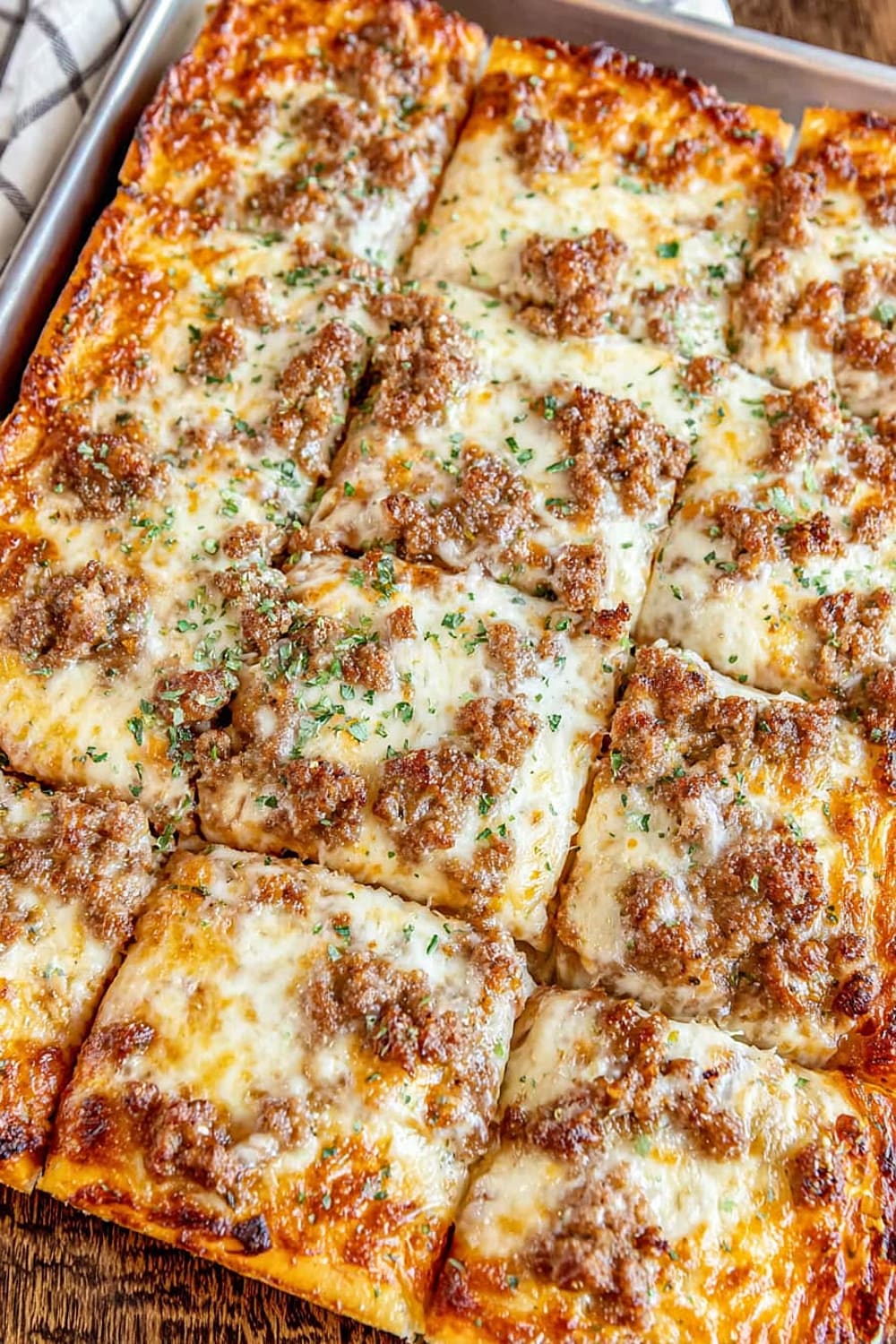
Make It Diabetes-Friendly
Flour & Carb Modifications:
- Replace 1 cup all-purpose flour with almond flour or coconut flour (use ½ cup coconut flour if substituting)
- Use whole wheat flour for the remaining flour to increase fiber content
- Consider cauliflower pizza crust mix as a lower-carb alternative base
- Estimated carb reduction: 8-12 grams per slice with partial flour substitution
Sugar Substitutions:
- Replace 2 tablespoons sugar with 1 tablespoon stevia blend or 2 tablespoons erythritol
- Monk fruit sweetener works well – use 1 tablespoon to replace the sugar
- The sugar feeds the yeast, so don’t eliminate entirely – minimal amounts are necessary for proper rising
Portion & Timing Tips:
- Cut into 16 smaller squares instead of 12 for better portion control
- Estimated carbs per smaller piece: 18-22 grams depending on modifications
- Pair with large green salad and grilled protein to balance blood sugar impact
- Fiber boost: Add 1 tablespoon ground flaxseed to the batter for extra fiber
Smart Serving Strategies:
- Eat pizza after consuming protein and vegetables to slow carb absorption
- Load up on low-carb toppings: bell peppers, mushrooms, spinach, olives
- Limit high-carb toppings: pineapple, thick sauce layers, extra bread-like toppings
Total Carb Reduction: Modifications can reduce carbs by 25-35% while maintaining the nostalgic cafeteria pizza experience.
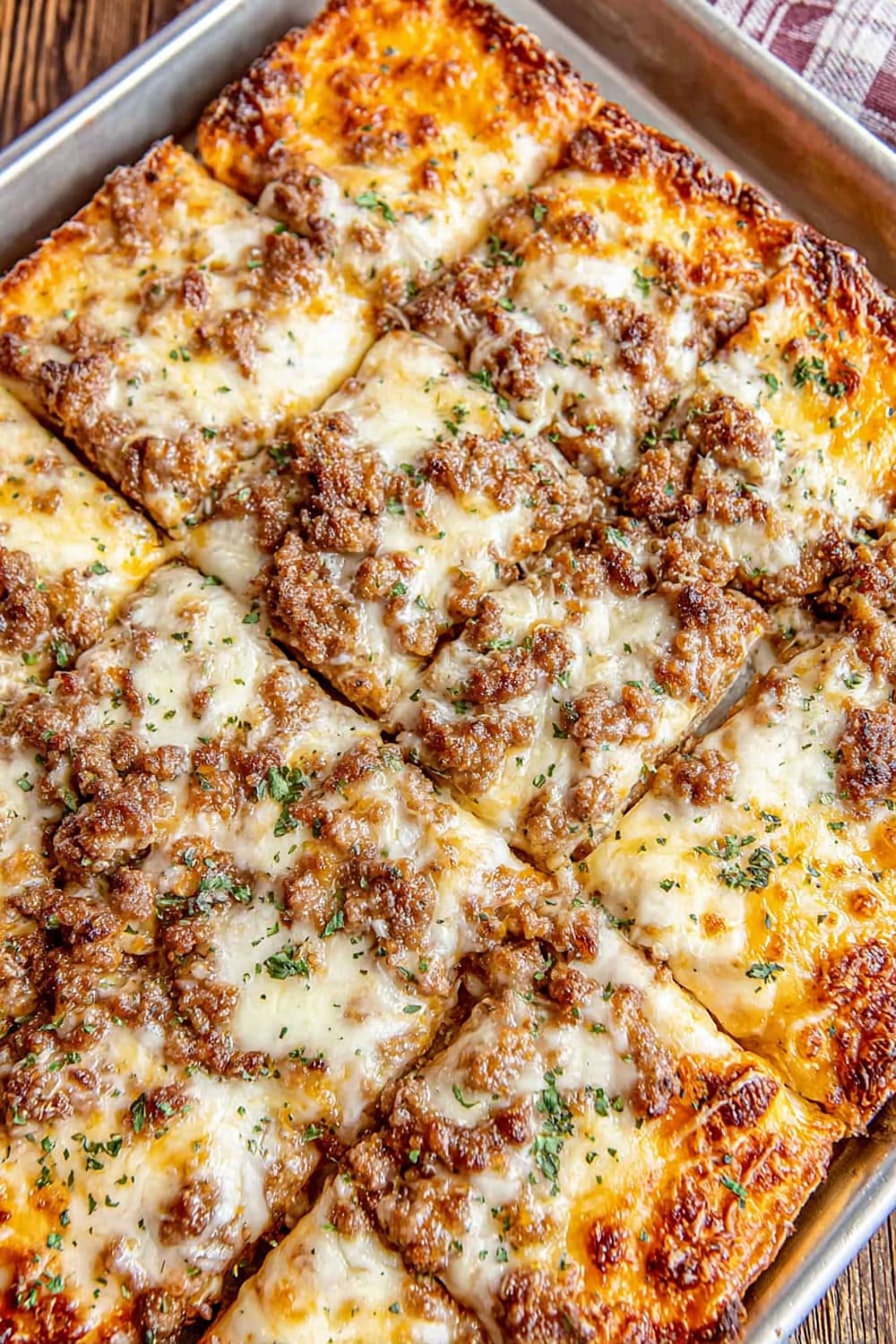
Perfect Pairing Suggestions
Beverage Pairings
The nostalgic comfort of cafeteria pizza pairs beautifully with cold milk for the ultimate throwback experience, or try craft root beer for a more sophisticated take on childhood flavors. For adults, a light lager beer or Chianti wine complements the simple tomato and cheese flavors without overwhelming the dish. Sparkling water with lemon cuts through the richness while keeping the focus on those familiar flavors that make this pizza special.
Side Dish Recommendations
Channel the full cafeteria experience with crispy tater tots or seasoned French fries, or elevate the meal with a fresh Caesar salad that adds crunch and acidity. Garlic breadsticks made from leftover batter create a cohesive bread-forward meal, while roasted vegetables like bell peppers and zucchini add nutritional balance. A simple coleslaw provides cooling contrast to the warm, cheesy pizza and adds beneficial fiber.
Complete Meal Ideas
Start with mozzarella sticks or stuffed mushrooms as appetizers that complement the cheese theme, then serve the pizza alongside buffalo cauliflower for adults or carrot sticks with ranch for kids. Chocolate chip cookies or vanilla pudding cups complete the nostalgic cafeteria experience perfectly. For entertaining, create a pizza bar with multiple topping options and let guests customize their squares.
Occasion Suggestions
This recipe shines at casual family dinners, kids’ birthday parties, and retro-themed gatherings where nostalgia is the guest of honor. Perfect for game day when you want something familiar yet special, or meal prep sessions since it freezes beautifully for quick weeknight dinners.
Pro Tips and Troubleshooting
Professional Techniques
The 10-minute mixing time isn’t negotiable – this extended mixing develops the gluten structure that gives cafeteria pizza its distinctive chewy-yet-tender texture that can’t be achieved with shorter mixing. Room temperature ingredients mix more evenly, so take your eggs and milk powder out 30 minutes before starting. Weigh your flour if possible – 2½ cups should equal approximately 315 grams for consistent results every time.
Common Mistakes and Solutions
If your batter seems too thick, resist adding extra water – the 20-minute rest period allows the flour to fully hydrate and the consistency will improve. Yeast not foaming means your water was too hot or the yeast is expired – start over with fresh yeast and 110°F water. Soggy bottom crust happens when you skip the cornmeal or don’t preheat the oven fully – that 475°F temperature is crucial for proper crust development.
Storage and Make-Ahead Strategies
Unbaked batter can be refrigerated up to 24 hours – just let it come to room temperature before spreading in the pan. Fully cooked pizza freezes beautifully for up to 3 months when wrapped in plastic wrap and foil. Reheat frozen slices directly from frozen at 375°F for 12-15 minutes to restore that crispy bottom and melted cheese top.
Scaling and Presentation
Double the recipe easily for large crowds – use two half-sheet pans and bake simultaneously. Cut into perfect squares using a pizza wheel or sharp knife, wiping the blade between cuts for clean edges that showcase those beautiful layers of crust, sauce, and cheese.
This cafeteria pizza recipe proves that sometimes the most beloved foods come from the most unexpected places – a government cookbook that understood comfort food long before it became trendy. Every rectangular slice delivers pure nostalgia with the added satisfaction of knowing you’ve mastered a technique that stumped home cooks for decades.